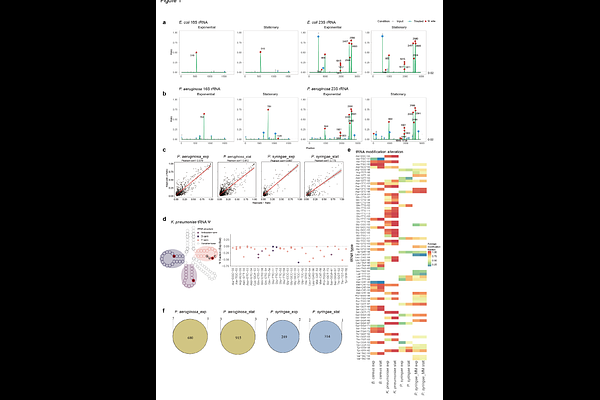Quantitative RNA pseudouridine landscape reveals dynamic modification patterns and evolutionary conservation across bacterial species

Quantitative RNA pseudouridine landscape reveals dynamic modification patterns and evolutionary conservation across bacterial species
Xu, L.; Shen, S.; Zhang, Y.; Guo, Z.; Lu, B.; Huang, J.; Li, R.; Shen, Y.; Zhang, L.; Deng, X.
AbstractPseudouridine ({Psi}) modifications are the most abundant RNA modifications; however, their distribution and functional significance in bacteria remain largely unexplored compared to eukaryotic systems. In this study, we present the first transcriptome-wide and quantitative mapping of {Psi} modifications across five diverse bacterial species (Bacillus cereus, Escherichia coli, Klebsiella pneumoniae, Pseudomonas aeruginosa, and Pseudomonas syringae) at single-base resolution, utilizing the optimized BID-seq method for bacterial RNA. Our analysis revealed growth phase-dependent dynamics of pseudouridylation in bacterial tRNA and mRNA, particularly in genes enriched in core metabolic pathways. Comparative analysis demonstrated evolutionarily conserved features of {Psi} modifications, such as dominant motif contexts, {Psi} clustering within operons, etc. Functional analysis indicated {Psi} modifications influence bacterial mRNA stability, translation, and interactions with specific RNA-binding proteins (RBPs) in response to changing cellular demands during growth phase transitions. The integrated computational analysis on local RNA architecture was conducted to elucidate the structure-dependent {Psi} modifications in bacterial RNA. Furthermore, we developed an integrated deep learning framework, combining Transformer-GNN-based neural networks (pseU_NN) to capture both RNA sequence and structural features for effective prediction of {Psi}-modified sites. Overall, our study provides valuable insights into the landscapes of bacterial RNA {Psi} modifications and establishes a foundation for future mechanistic investigations into the functions of {Psi} in bacterial RNA regulation.